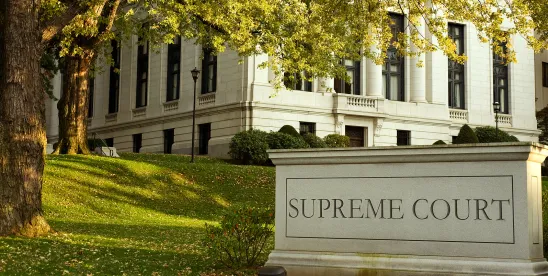The Supreme Court recently ruled for the second time that federal district courts likely lack jurisdiction under the Administrative Procedure Act (“APA”) to hear challenges to terminations of federal grants. The first such ruling came in April of this year, when the Court granted an emergency stay in California v. Department of Education. On August 21, 2025, the Supreme Court issued another emergency stay, in NIH v. American Public Health Association, reaffirming the view that challenges to grant terminations are, in substance, breach of contract actions for money damages that belong in the Court of Federal Claims under the Tucker Act.
Since California, several lower courts have nevertheless asserted jurisdiction over grantee lawsuits seeking reinstatement of terminated grants, often distinguishing California on procedural or factual grounds. We have previously written about some of those cases (including Massachusetts v. Kennedy, which was later consolidated with NIH). Although the Supreme Court’s decision in NIH is an interim order, the jurisdictional question may now be functionally settled, particularly given Justice Gorsuch’s admonishment to lower courts that even if they “sometimes disagree with this Court’s decisions…they are never free to defy them. When this court issues a decision, it constitutes a precedent that commands respect in lower courts.” Following NIH, we expect terminated grantees will largely be forced into the Court of Federal Claims, which generally does not have authority under the Tucker Act to grant the equitable relief—reinstatement of grants—that many of them are seeking.
Background
In February 2025, the Trump administration issued a series of executive orders directing federal agencies, including the National Institutes of Health (“NIH”), to realign funding priorities—specifically, to halt support for activities related to diversity, equity, and inclusion (“DEI”); gender identity; and COVID-19. NIH responded by issuing internal guidance documents describing the new funding priorities and, over a period of 90 days, terminated thousands of existing grants.
Affected researchers, unions, and a coalition of 16 states sued in the U.S. District Court for the District of Massachusetts, asserting that NIH’s guidance documents and resulting terminations were arbitrary and capricious under the APA. After a bench trial, the District Court entered a partial final judgment for plaintiffs, vacating both the guidance and the terminations. The Government sought a stay of the judgment pending appeal to the U.S. Court of Appeals for the First Circuit on the sole ground that the Tucker Act divested the District Court of jurisdiction. After the First Circuit denied the stay, the Government filed an emergency application to the Supreme Court.
The Supreme Court’s Split Decision
In a 5-4 ruling, the Supreme Court stayed the portion of the District Court’s judgment vacating the grant terminations. The majority held that the District Court lacked jurisdiction to hear challenges to terminations of grants or to order NIH to pay money due under the grants. Citing its recent ruling in California, the Court reasoned that such disputes are based on an express or implied contract with the United States and therefore belong in the Court of Federal Claims.
Justice Gorsuch, concurring and dissenting in part, chastised the District Court for not following California. While he acknowledged that California granted only interim relief pending appeal, he stressed that the decision was nonetheless binding precedent that must be “respected” in lower courts. He noted that, as in California, the plaintiffs’ injury and alleged right to payment stemmed from NIH’s refusal to disburse grant funds according to the terms and conditions of the grants. In a separate concurrence, Justice Kavanaugh similarly concluded that plaintiffs’ claims sound in contract and therefore belong in the Court of Federal Claims under the Tucker Act.
Notably, while the Court allowed the grant terminations to proceed—and directed challenges to those terminations to the Court of Federal Claims—the Court declined to stay the District Court’s judgment vacating NIH’s internal guidance. On this particular issue, Justice Barrett cast the deciding vote, and wrote separately to clarify that the challenge to NIH’s guidance relating to grant terminations are not contract claims that belong in the Court of Federal Claims. As a result, theDistrict Court could potentially vacate NIH’s guidance under the APA, which would prevent the NIH from relying on that guidance going forward. But Justice Barrett agreed with Gorsuch and Kavanaugh that plaintiffs challenging prior grant terminations belong in the Court of Federal Claims. Justice Jackson wrote in her strongly worded dissent that forcing plaintiffs to pursue simultaneous relief in two separate forums is unnecessary and unworkable, particularly given that 28 U.S.C. § 1500 bars the Court of Federal Claims from hearing claims pending in other courts based on “substantially the same operative facts.”
Dissenting Opinions
The dissenting justices—Roberts, Sotomayor, Kagan, and Jackson—believe that the NIH guidance is final agency action that the District Court had jurisdiction to set aside under the APA, and because the challenged grant terminations resulted directly from the NIH guidance, the District Court also had jurisdiction to set aside the terminations.
Justice Jackson wrote separately to criticize the California decision as under-developed and wrongly decided. As she did in California, she disagreed with the majority’s view that plaintiffs had alleged breach of contract claims, rather than statutory claims to enforce agency compliance with the APA’s requirement for reasoned decision-making. Justice Jackson also cautioned that plaintiffs would be denied an effective remedy because the Court of Federal Claims cannot reinstate funding or provide equitable relief. She further observed that plaintiffs have no practical relief, because even if district courts have jurisdiction to vacate unlawful agency guidance, the majority of the justices believe that district courts cannot restore grants terminated pursuant to the NIH guidance, which the Court of Federal Claims also cannot do.
Conclusion
The Supreme Court’s decision in NIH v. American Public Health Association signals that future challenges to grant terminations will likely be limited to contract law claims. By suggesting that the Court of Federal Claims has exclusive jurisdiction over such disputes, the decision significantly restricts grantees’ ability to seek equitable relief—especially reinstatement of funding, which is often their primary concern. Although the ruling allows district courts to review unlawful agency guidance under the APA, it raises the risk of fragmented, parallel litigation that may still fail to provide meaningful relief. While the Supreme Court has left open the possibility of revisiting these issues on the merits, its message is clear and its decision will likely deter future district court challenges, at least in the near term.




 />i
/>i

